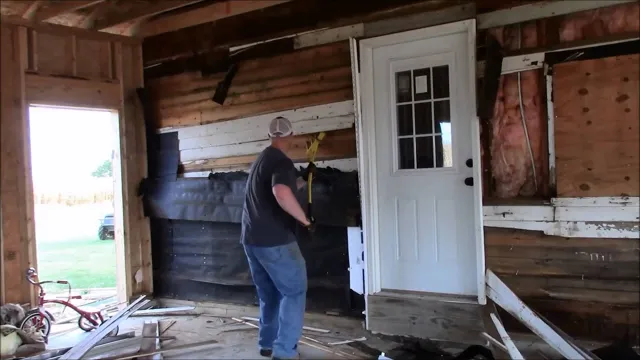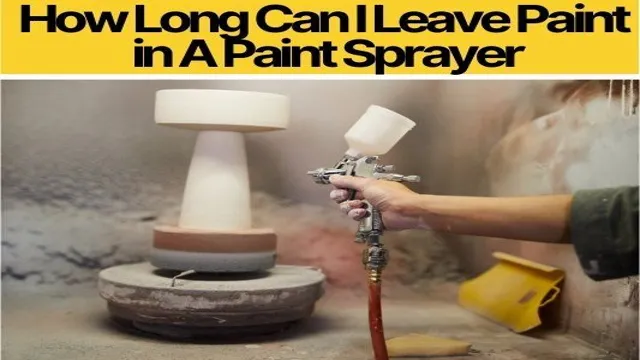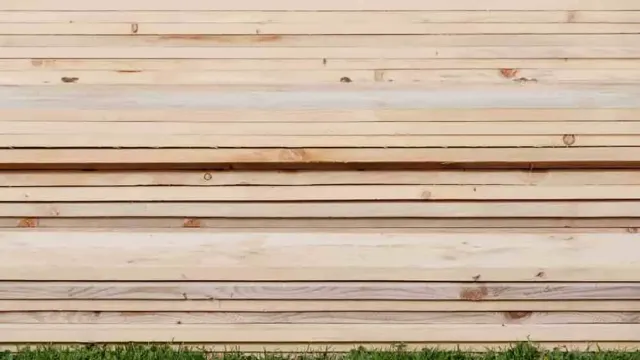
Are you thinking of giving your home a new look and are considering removing the wood siding? Perhaps you’re tired of the maintenance that comes with it, or maybe you want to update the appearance of your home. Whatever the reason may be, removing wood siding is a big undertaking that requires careful consideration and planning. But with the right tools, knowledge, and patience, you can easily remove wood siding and give your home the facelift it deserves.
In this step-by-step guide, we’ll take you through the process of removing wood siding from your home. We’ll cover everything from the tools you’ll need to the best practices to follow to ensure a successful removal. We’ll also discuss safety precautions to take throughout the process, from protecting yourself to safeguarding your home.
Removing wood siding can be a time-consuming process, but with our guide, you’ll be able to tackle the project with confidence. By the end of it, you’ll be ready to move on to the next step: selecting the new siding for your home. Let’s get started!
Preparation
If you’re looking to remove wood siding from your home, it’s important to prepare properly before beginning the project. First, gather all the necessary tools and equipment, including gloves, safety glasses, a pry bar, hammer, and reciprocating saw. You may also need scaffolding or a ladder to reach higher parts of the siding.
Next, take a close look at the siding to determine if any repairs need to be made before removal. Look for areas with water damage or rot, and replace any damaged boards before starting. It’s also a good idea to cover any windows or doors with plastic sheeting to protect them from debris.
Finally, consider enlisting the help of a friend or professional if the job seems too daunting or if you’re unsure about your abilities. With the right preparation, you can successfully remove your wood siding and give your home a fresh new look.
Gather Tools and Materials
If you want to start a DIY project, gathering your tools and materials is the most crucial step in the preparation process. Before you start, spend some time evaluating what materials and tools you need, and make a list. You don’t want to be halfway through the project and realize you forgot something essential.
After creating your list, check what tools you have and what you need to purchase or borrow. You might not need to buy everything, especially if you’re working with friends or family. Borrowing tools can save you money and build relationships, so don’t be afraid to ask around.
When it comes to materials, choose high-quality ones that will last. Cheap materials can lead to a weak and unstable finished product. Ensure that you have enough of each material and factor in extras for mistakes or changes.
Remember, the quality of your tools and materials will determine the success of your project.

Prepare the Work Area
Before you start working on any project, it’s important to prepare the work area to ensure that you have everything you need nearby and that the area is free of any hazards. Start by clearing any clutter from your workspace, organizing your tools and materials, and ensuring that you have enough space to work comfortably. This will help you stay focused and avoid distractions while you work.
It’s also crucial to assess the environment around you to identify any potential risks, such as tripping hazards or flammable materials that could pose a danger. By taking the time to prepare your work area, you’ll be setting yourself up for success and helping to ensure that your project is completed safely and efficiently. Remember, a little preparation goes a long way!
Removing the Wood Siding
Removing wood siding is a task that can add much-needed warm and homey aesthetics to your house. Firstly, it’s important to check with local building codes, as wood siding might contain hazardous materials, such as lead paint. Once you have access to the right safety gears and tools, it’s time to start.
Begin by removing any screws or nails that hold the wood siding in place. Then, using a hammer and a pry bar, gently loosen and remove the boards one at a time. Keep the removed boards in a safe area to avoid any potential injuries.
You may encounter some damaged or rotten boards, which will need to be addressed before installation of new siding. As a final step, clean and prep the exterior surface to ensure a smooth and long-lasting application of new siding. By following these steps, you can remove the old, worn-out wood siding and replace it with a fresh look to enhance the exterior of your home.
Locate and Remove the Nails
When it comes to removing wood siding, the first step is to locate and remove the nails. This can be a tedious and time-consuming process, but it’s crucial to ensure the siding comes off without damage. You’ll need a pry bar, hammer, and gloves to protect your hands.
Begin by examining the siding to see where the nails are located. Usually, they’re on the top of the board or in between the joints. Once you’ve found them, carefully insert the pry bar between the siding and the wall and gently leverage the board towards you to loosen the nails.
With your hammer, pull out the nails one at a time, being careful not to damage the siding or walls. Remember to pay attention to any staples or screws that may be securing the siding in place and remove those as well. Once all the nails are out, you can proceed to remove the siding, one board at a time.
By taking the time to carefully remove the nails, you’ll ensure that the wood siding comes off with minimal damage, making any repairs or replacements easier in the long run.
Use a Pry Bar to Loosen the Siding
If you’re looking to remove wood siding, you’ll need a pry bar. A pry bar is a great tool to loosen the siding because it can get into tight spaces and apply the necessary force to remove the siding. Begin by finding the trim on your exterior walls.
Once located, insert the prying end of the bar behind the wood siding. Push the bar outward in a perpendicular motion to remove the siding from the wall. Repeat this process for each plank of siding you want to remove.
Be careful not to damage the surrounding area, and keep all removed materials organized. By using a pry bar, you can efficiently and effectively remove wood siding without breaking a sweat. So, go grab your trusty pry bar and get to work!
Work in Sections
Removing the wood siding of a house can be a daunting task, but with the right tools and technique, the job can be done efficiently. It is important to work in sections, as removing all the wood siding at once can create a mess and make it difficult to keep track of which pieces belong where. Start by identifying one section at a time and removing the nails or screws that hold the wood in place.
A pry bar can be used to carefully lift the section of siding away from the house. It is crucial to not damage the wood or the underlying structure during this process. The use of protective eyewear and gloves is also recommended to ensure safety during the project.
With patience and attention to detail, removing wood siding can be done with ease, leading to successful home improvement projects.
Cleaning Up
If you’re looking to give your home a fresh new look, removing wood siding is an excellent place to start. But how do you do it? First, make sure you have the right tools on hand. You’ll need a pry bar, a hammer, and a reciprocating saw if you want to make the job go faster.
Begin by prying off the outermost pieces of wood siding, using the pry bar to loosen the nails. Once you have a good section of siding removed, you can start using the reciprocating saw to cut through the nails and pull out the boards. Be sure to wear gloves and safety glasses as you work, and take care not to damage the underlying structure of your home.
With a little patience and elbow grease, you’ll have your old wood siding removed in no time.
Discard Siding and Nails Properly
When it comes to renovating your home, it’s important to think about the cleanup process as well. One thing that often gets overlooked is how to properly discard old siding and nails. Simply throwing them in the trash can cause harm to both people and the environment.
The best way to dispose of siding and nails is to bring them to a recycling center or hazardous waste disposal facility. This not only ensures safe handling and disposal but also helps to reduce waste in landfills. Additionally, consider using a magnetic nail sweeper to gather any leftover nails.
This helpful tool will pick up any stray nails that could potentially cause harm to people or pets. Remember, proper cleanup is just as important as the renovation itself.
Sweep and Clean the Work Area
When it comes to completing a project, cleaning up may not be the most exciting part, but it is a crucial step. After you’ve finished your work, it’s essential to sweep and clean the work area thoroughly. Not only does this make the space cleaner and more pleasant to work in, but it also ensures that any debris or materials left behind won’t cause accidents or hinder future projects.
So grab a broom and dustpan, and sweep up any sawdust, wood chips, or dirt left on the floor. Don’t forget to wipe down any surfaces with a clean cloth, remove any tools or materials that are no longer needed, and dispose of any waste safely and responsibly. By taking the time to clean up, you’re not only keeping the area safe, but you’re also setting yourself up for success on your next project.
Conclusion
In conclusion, removing wood siding may seem like a daunting task, but with the right tools and techniques, it can be accomplished with ease. Remember to take your time, stay organized, and don’t be afraid to ask for help if needed. Just like peeling off a sticker, removing wood siding requires patience and a steady hand.
So go ahead and give your home a makeover, and let those beautiful new colors and textures shine through. After all, a fresh coat of paint on your house can do wonders for your curb appeal. Happy remodeling!”
FAQs
What tools are needed to remove wood siding?
You will need a pry bar, hammer, circular saw or reciprocating saw, ladder, safety goggles, and work gloves.
How do I prepare the area before removing the wood siding?
Before removing the wood siding, you should first remove any obstacles in the work area, including outdoor furniture, potted plants, and other items. Next, cover nearby plants or landscaping with drop cloths or plastic sheeting.
Can I remove wood siding myself or should I hire a professional?
While removing wood siding can be a DIY project, it is important to keep in mind that it can be time-consuming and labor-intensive. If you have experience with home improvement projects and the necessary tools, you may be able to do it yourself. However, it may be best to hire a professional if you have little experience or knowledge of removing siding.
How long does it take to remove wood siding?
The amount of time it takes to remove wood siding depends on the size of the area and the extent of the damage. On average, it can take anywhere from a few hours to several days to remove wood siding from a home.
How do I protect the remaining siding during the removal process?
To protect the remaining siding during the removal process, you can cover it with a tarp or plastic sheeting. You can also use tape to hold the tarp or plastic in place and prevent it from moving or slipping.
Can I reuse the removed wood siding?
The condition of the removed wood siding will determine whether it can be reused or not. If the siding is in good condition with no signs of rot or damage, it may be possible to reuse it. However, if the siding is damaged or in poor condition, it may need to be replaced.
How do I dispose of the removed wood siding?
The best way to dispose of the removed wood siding is to check with your local recycling center or landfill. They can provide instructions on how to properly dispose of the wood siding, and whether it can be recycled or not.







